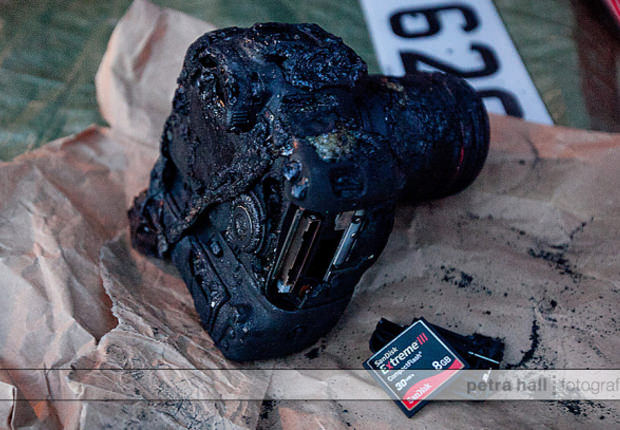 (Credit: Petra Hall) found on Cnet.com (Credit: Petra Hall) found on Cnet.com |
Even moderately priced digital cameras are being engineered and built to withstand harder knocks, weather extremes and other potential catastrophes, but a significant car fire will transform the best of cameras into a barely recognizable blob of melted plastic and scorched metal. If you’re lucky, then the contents of a memory card may have not been affected; but you can generally count on the camera and lens being a total loss.
According to the National Fire Protection Association (NFPA), there were an estimated 215,500 car fires in the United States during 2010. These caused 310 deaths, 1,600 injuries and more than $1.4 billion in property damage.
Whether you’re a beginner photographer, enthusiast, hobbyist, amateur or professional, these statistics should certainly motivate you to take appropriate precautions. Of course, first, you shouldn’t leave your camera in your car, both because of the possibility of a car fire and maybe more importantly, your photography equipment is even more vulnerable to car theft.
Although vehicle theft has been steadily declining, approximately 713,000 vehicles were stolen during 2011 in the US. That may be the lowest total since 1967, but still, according to the Insurance Information Institute, only 11.8% of thefts are cleared. The FBI reports that a motor vehicle is stolen in the US every 43 seconds.
If you find that you often leave cameras and other photography equipment in your car or a van or other type of vehicle, as a professional, then the National Insurance Crime Bureau recommends that you consider using any or all of the following technologies: warning devices, car immobilizing technology and tracking devices.
Car fires are more difficult to prevent than theft, since malfunctions, oil or gas leaks or accidents can cause car fires. Whenever you schedule regular maintenance on your vehicle, it’s a good idea to ask the mechanic to check for any potential fuel leaks and to check if there any recalls for your vehicle that may relate to “spontaneous” car fires.
The other step you can take to protect your photography equipment from car fires is to be sure you have the right insurance coverage in place. Don’t assume your homeowner’s policy or car insurance covers cameras, lenses, etc. that may be destroyed during a car fire. For example, car insurance does not cover the theft of personal possessions from your car. Typically, comprehensive coverage, which is separate from collision coverage, would apply to possessions damaged or destroyed during a car fire or most other incidents other than a collision with another vehicle. State law doesn’t necessarily require comprehensive coverage; and even if you do buy it, it often has a deductible amount, $100 to $500, which means money from your pocket to replace your equipment before the policy goes into effect. Typically, you must pay a higher premium for a lower the deductible.
You must weigh the value of either paying a higher premium or a higher deductible. For instance, if you have a compact camera worth a few hundred dollars that you rarely leave in your car, but on the one occasion you do, it is destroyed in a car fire, then a low deductible/high premium probably isn’t a good choice. Conversely, if you are a professional photographer that is more likely to leave some of your equipment in a car or van because there is simply too much of it to remove and carry on every shoot, then paying a higher premium for a lower deductible may make sense.
The best course of action, especially for the professional photographer, is to contact a company like Package Choice that specializes in insurance coverage for photographers. The experts there will be able to assess your exact needs based on the type of photography you do, how much equipment you own, whether you store it at your home or a separate business location, etc.
Also Read: 23 THINGS YOU MUST KNOW TO BE SUCCESSFUL IN PHOTOGRAPHY
Recommended Reading:
- 2013 Photographer's Market: The Most Trusted Guide to Selling Your Photography
- Best Business Practices for Photographers
- The Fast Track Photographer Business Plan: Build a Successful Photography Venture from the Ground Up
- Group Portrait Photography Handbook
- 500 Poses for Photographing Women
- The Best of Family Portrait Photography: Professional Techniques and Images
- 500 Poses for Photographing Group Portraits
- Selling Your Photography: How to Make Money in New and Traditional Markets
- Starting Your Career as a Freelance Photographer
- Photographer's Survival Manual: A Legal Guide for Artists in the Digital Age
- Legal Handbook for Photographers: The Rights and Liabilities of Making Images
- Taking Stock: Make money in microstock creating photos that sell
- Going Pro: How to Make the Leap from Aspiring to Professional Photographer
People who read this PhotographyTalk.com article also liked:
Your feedback is important to thousands of PhotographyTalk.com fans and us. If this article is helpful, then please click the Like and Re-Tweet buttons at the top left of this article.
